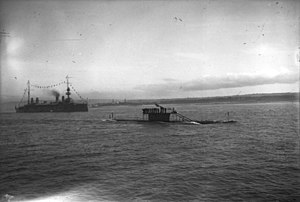Émeraude-class submarine

Émeraude in Cherbourg harbour, 31 July 1909
|
|
| Class overview | |
|---|---|
| Name: | Émeraude-class |
| Operators: |
|
| Preceded by: | Oméga |
| Succeeded by: | Circé class |
| Built: | 1903–10 |
| In commission: | 1908–21 |
| Completed: | 6 |
| Lost: | 2 |
| Scrapped: | 4 |
| General characteristics (as built) | |
| Type: | Submarine |
| Displacement: |
|
| Length: | 44.9 m (147 ft 4 in) (o/a) |
| Beam: | 3.9 m (12 ft 10 in) |
| Draft: | 3.8 m (12 ft 6 in) |
| Installed power: | |
| Propulsion: |
|
| Speed: |
|
| Range: |
|
| Test depth: | 40 m (130 ft) |
| Complement: | 2 officers and 23 crewmen |
| Armament: | 6 × 450 mm (17.7 in) torpedo tubes (4 × bow, 2 × stern) |
The Émeraude-class submarines was a group of six submarines built for the French Navy during the first decade of the 20th century. One boat was sunk and another captured during the First World War and the survivors were scrapped after the war.
The Émeraude class were built as part of the French Navy's 1903 building programme to a Maugas design. They had a single hull, and a displacement of 392 tons surfaced (425 tons submerged). For surface propulsion the Émeraude class had petrol engines, and electric motors for when submerged, giving an surface endurance of 200 miles at 7.3 knots and a submerged endurance of 100 miles at 5 knots, with a maximum surface speed of 11.5 knots, and a submerged speed of 9.2 knots. Their armament was six torpedo tubes (4 forward and 2 aft). Topaze and Turquoise had a single 37mm gun, and were manned by crews of 21 men (later increased to 23 men).
...
Wikipedia
